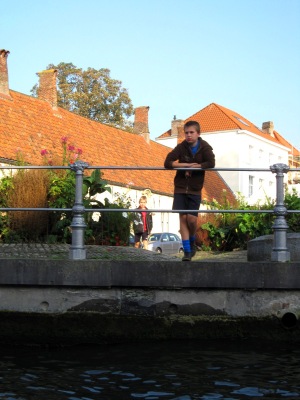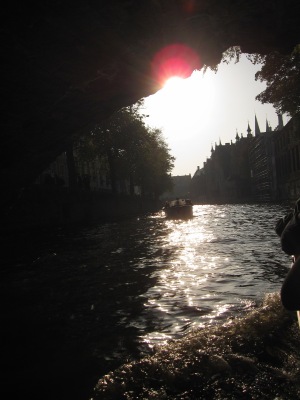Clockwise: ducks and swans swim through the canals of Bruges; a hot air balloon rises above the city; the Grote Markt belfry dominates the skyline; old advertisement for Trappist-made beef chocolate using raw meat, designed to fight fatigue
Bruges is a quaint little town located in West Flanders, in a Flemish-speaking section of Belgium. The Gothic architecture of the old city center is recognized as a UNESCO Heritage site, and the town is often nicknamed the “Venice of the North,” due to the network of canals traversing the city. Like the center of Brussels, Bruges features a stunning central public square named Grote Markt, which includes the Belfort tower housing a 47-bell carillon. You can climb the 366 steps to reach the top of the 83 m tower for an aerial view of the city. It seems that the carilloneur’s repertoire is as diverse as that of Cornell chimesmasters; all afternoon, the air was filled with the tinkling of baroque and Billy Joel.
Clockwise: chocolate by the kilo sourced from a variety of nations; the Chocolate Shooter, for inhaling cocoa powder; Choco Frites, or white chocolates shaped like fries; an explanation at the Chocolate Museum on how chocolate prevents cavities
Of course, we were here primarily for the chocolate. Despite its compact size, Bruges is known as one of the European centers for chocolate, and upon arriving, we beelined to the Chocolate Line. Helmed by “shock-a-latier” Dominique Persoone, the Chocolate Line presents a fairly traditional wood paneled storefront, where you can buy pralines with everything from nuts to guacamole to wasabi. For those interested in bulk purchases by the kilo for their own chocolate work, you can choose from about a dozen chocolates sourced from the Americas and Africa. however, my attention was caught by the Chocolate Shooter, where the user inhales a mixture of chocolate powder and ginger or chocolate and raspberry, intended to open up your palate to better appreciate fine chocolates or a dessert course. Gimmicky? Perhaps, but I still respect Persoone’s decidedly more traditional work in tracing the origins of chocolate through history. Cacao: the Roots of Chocolate details Persoone’s travels in Mexico and Central America, as he visits Mayan settlements, cocoa plantations and modern-day markets. In an era of lengthy food chains and commodification, it is refreshing to see a chocolatier who tries to close the distance between himself and his products.
Bruges is also home to the Choco-Story museum. (The same directors also run museums on house lamps and fries; Belgians love their niche museums.) The museum houses several rooms of bulletin boards and exhibits on the history of chocolate, along with some chocolate molds, equipment and other knick-knacks, like historical chocolate tins emblazoned with the faces of the Belgian royal family. I was amused by the FAQs that tried to answer questions like whether chocolate makes you fat. (“If you are slim, no you will not gain weight. If you are overweight, slim down first, then reintroduce chocolate.”) Liz commented that this was similar to the Tiger Beer museum, which assures you that beer does not cause a beer belly.
Although the displays were a little dusty and text-heavy, there was a live demo downstairs with a chef making chocolates in a display kitchen. While setting down a freshly-poured mold with one hand, he deftly pulled out cooled chocolate pieces from under the counter and unmolded them for us to sample. Admission to the museum is €6/5 for students.
PostChocostory Museum, we joined the queue for the tour boats that line the canals. For €6, you will receive a thorough introduction to Bruges and see parts of the city that are otherwise inaccessible by foot. Our guide was perhaps not as impeccably dressed as a traditional Venetian gondolier, but he was well-versed in Bruges history and fluent in several languages. Over the next 45 minutes, we took in the setting sun while our boat navigated around the swimming swans and under the low stone bridges.
After nightfall, Bruges maintains its energy in the town’s restaurants, pubs and nightclubs. After a dinner of lapin a la Flamandes (Flanders-style rabbit with prune sauce), we ended up in Eiermarkt Square, which features a good mix of open-air cafes, bars and clubs pumping house music and spinning disco balls. The party continues all night until you’ve drunk your share of Tripels.













See, you are slim, chocolate will not make you fat!
Yes, all the information was wholly accurate, and the tar chocolate vapors are good for your lungs.